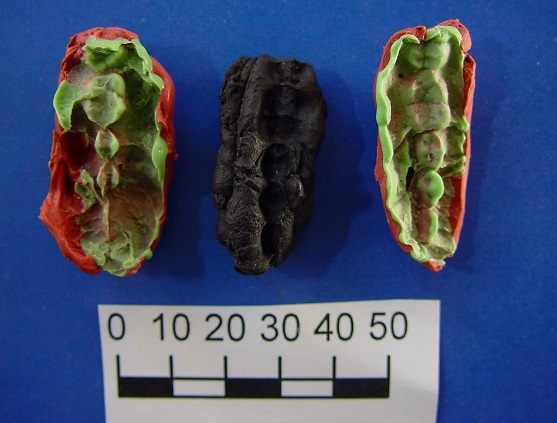Ancient Gum Reveals Stone-Age Teens Chewed on Bones and Made Poison
And had some pretty bad oral health.
Our Stone Age forebears chewed gum just like us—except their version of “gum” was actually a tarry tree resin, and we can be sure it tasted nothing like Wrigley’s Doublemint. Samples of this birch pitch still embedded with 10,000-year-old tooth marks were discovered in Sweden several decades ago, but a recent study has revealed more about what the prehistoric teenagers ate and other activities they did with their teeth.
The study, published last week in the journal Scientific Reports, says the gum unearthed in the ‘90s at an archaeological site called Huseby Klev, on Sweden’s west coast, was likely chewed by teens and children as young as five years old between 9,890 and 9,540 B.C. The pieces contained traces of animals, revealing that they ate wolf, arctic fox, and a type of aquatic snail called a limpet, among other birds and fish. It appears that hazelnuts and crab apples were also enjoyed shortly before the youths popped the pitch into their mouths, which they could have done for a number of reasons.

“They were chewing these pitch pieces mainly in material culture to assemble new tools,” says the lead author of the study, Emrah Kırdök, who is an assistant professor at Mersin University in Turkey. They could, for example, use the arboreal glue to make an ax out of flint and wood or to patch a leak in a boat. Kırdök says the substance would have looked almost like today’s gum except for the sooty color. It would have been produced by burning bark and scraping the resin off a rock.
The primary focus of the study was not the gum itself, though, or why Stone Age folk would have chewed it; researchers looked for what the masticated resin still harbored after all these thousands of years, and what it reveals about prehistoric health and culture. In addition to traces of things eaten during this period—such as brown trout, turtle dove, mallard, and red deer—the team discovered dozens of bacteria associated with gum disease and tooth decay that indicate “poor oral health during the Scandinavian Mesolithic,” according to the study. This is information we might have assumed but wasn’t previously as evident.
The birch tar likely isn’t to blame for this poor oral health, Kırdök says. Instead, microbes would have been introduced through the frequent use of the teeth as tools. The ancient Scandinavians used their teeth to prepare clothing out of animal furs and whittle bones into various utensils. The gum also showed that the children bit into mistletoe, a plant they laced their arrowheads with to make them poisonous. “We are capturing a moment in the Stone Age with great detail,” Kırdök says.

Thanks to its antimicrobial properties, the birch tar might have even helped reverse some of the damage they inflicted on their teeth. “If the pitch removed plaque and debris from the tooth surface, there could have been some benefit,” says Marin Pilloud, University of Nevada professor and president of the Dental Anthropology Association.
It’s also possible that chewing the tar alleviated some tooth pain, or perhaps that it was chewed for enjoyment, she says, just like when kids chomp on Juicy Fruit today. Birch tar is a natural antiseptic and is still used for medicinal purposes in the present day, so it could have also served as a sort of prehistoric toothpaste. Unfortunately, it wouldn’t have been enough to stop the tooth decay.
Gastro Obscura covers the world’s most wondrous food and drink.
Sign up for our regular newsletter.



















Follow us on Twitter to get the latest on the world's hidden wonders.
Like us on Facebook to get the latest on the world's hidden wonders.
Follow us on Twitter Like us on Facebook